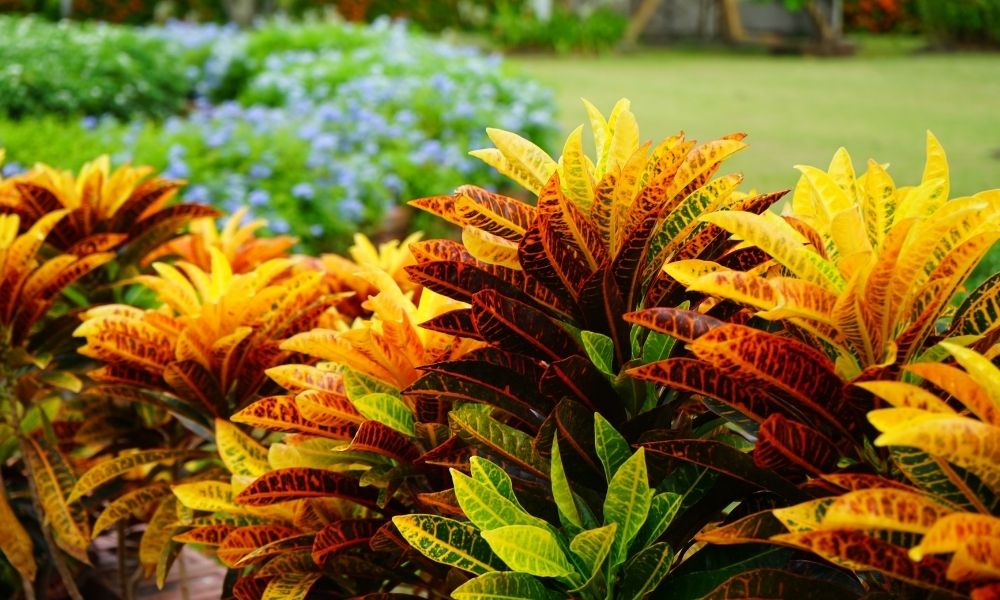Codiaeum
With its vibrant hues of red, orange, yellow, and green, the Codiaeum variegatum, commonly known as the Croton plant is just two colors short of a rainbow delight. This tropical, beachy plant is a sight to behold all year long. Place a Croton plant in your home and all of your guests will think you’re some sort of exotic plant connoisseur.
What is a Croton Plant?
Croton plants (Codiaeum variegatum) are perennial evergreen shrubs that hail from Malaysia and India. Each Croton, pronounced “crow-tun,” is bursting with a unique array of rich colors reminiscent of sunsets. These plants are so unusually beautiful and add striking, flowerless beauty to your home.
Plant Size
Some varieties of Crotons can grow up to 10 feet tall! However, most common household Croton plants cap off around three feet. The large, colorful leaves cluster near the base then fan widely outward, adding voluminous width to the Croton plant.
Light
Croton plants need as much bright, direct sunlight as possible throughout the day. When you bring a Croton home, look for the windowsill or table that gets the most sunlight in your house. The more sunlight your Croton plant absorbs, the more vibrant its gorgeous colors will be.
Watering
When caring for your Croton, remember that it flourishes in consistently damp soil that replicates its natural tropical environment. As the top layer of soil begins to feel dry to the touch, the time to water is approaching. Try to keep your Croton’s soil moist but not wet. Water the plant less frequently in the winter/fall than in the spring/summer.
Temperature/Humidity
To further mimic the Croton plant’s natural environment, you’ll want to ensure the plant gets enough humidity. Misting your Croton every few days will help. If you live in a dry area, you may want to consider investing in a humidifier – this will help your Croton AND benefit you!
Codiaeum Variegatums prefer warm environments of around 65° to 80° Fahrenheit. Do your best to avoid exposing your Croton to temperatures below 55° as this can cause the leaves to wilt. As long as your Croton spends its days in the sun and away from the air conditioner, it should be just fine.
RELATED: PLANT CARE 101 - THE TOP 10 TIPS FOR NEW OWNERS

Why Choose a Croton Plant for Your Home?
Codiaeum Variegatum plants are widely popular houseplants because of their perennial beauty and resilience. Flowering houseplants are no doubt beautiful, but the bright colors only last for a short time. The Croton plant’s gorgeous, colorfully variegated leaves remain vibrant for most of the year.
Like a few other houseplants, Crotons have moderate air-purifying abilities. As you enjoy their striking beauty, you can also rest easy knowing that they’re removing harmful toxins from your home.
Croton Plant Family Relatives
The Croton plant has a BIG family. Most of the time, “Croton” is used as an umbrella term for the different varieties, which can get a bit confusing. Many of the various Croton species are quite similar in appearance, but some have their own unique qualities.
Bush on Fire Croton
The Bush on Fire Croton is a stunning Croton variety. Its leaves, thinner than other varieties, are drenched in bold spots of orange, purple, gold, and red – hence the name “Bush on Fire.” If you’re looking for a truly unique and striking houseplant, the Bush on Fire Croton is an excellent choice.
Gold Dust Croton
This delicately pretty Croton variety features a dusting of golden spots atop bright green leaves. Gold Dust Crotons are beloved for their dazzling appearance and long life spans. They’re slow growers and tend to do well when they’re grouped with other Croton plants in a pot that gets plenty of sunlight.
Zanzibar Croton
Zanzibar Crotons are quite different looking from the “classic” Croton. Rather than broad, multi-colored leaves, the Zanzibar Croton features long, thin leaves that each feature one different color. Zanzibar Crotons almost resemble thick, rainbow Spider plants with their slender, grass-like leaves.
Final Thoughts
If your house needs a burst of color and a touch of nature, we highly recommend the distinctive, tropical Croton plant. As long as you place them in direct sunlight and keep to a watering schedule, your Croton will flourish and add vibrant beauty to your home all year long.